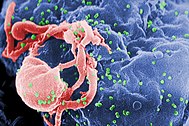What is HIV? [1]
HIV or the Human Immunodeficiency Virus targets vital cells (helper T-cells, specifically CD4+ T-cells, macrophages and dendritic cells) in the human immune system thereby compromising one's ability to fight off infection. While someone may be HIV-positive (infected with HIV), the signs and syntomns of the infection may not be obvious or it may not even present any syntomns of unwell; which in the words of a virologist - HIV is a very good (elusive) virus or rather it presents an interesting set of problems. While there are therapies and drugs (High Active Antiviral Therapy HAART) that can specifically target the proliferating virus, a lot of times it just ends in empty hope; as that small window of being "cured" of the virus is but a brief respite, or a guise for the virus latency as it awaits safely within the host for another chance to start propagating. So while being infected may not affect a person in one or two day's time, it sure as hell would do a lot of damage as the AIDS becomes fully-blown, as the immune system give way to your daily interaction with a cocktail of diseases. (Perfect condition in which opportunistic infections and cancer thrives)

Signs & Syntomns of HIV infection [2]
As the HIV come out of it latency and it can start infecting the healthy cells that carry the protein CD4 (e.g macrophage , dendritic cells and CD4+ T cells). As the CD4+ T cells population dwindles due to HIV infection, the body's capability to recognize pathogens and target them also starts to fail; which enables these opportunistic pathogens that would normally elicit an immune response from the helper T-cell to bypass the screening process completely. This then increase the likelihood for opportunistic infections:
Opportunistic Infections: Brain
References
[1] http://en.wikipedia.org/wiki/HIV
[2] http://www.ucsfhealth.org/conditions/aids/signs_and_symptoms.html
No comments:
Post a Comment